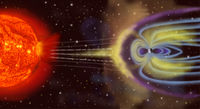
Photo from wikipedia
Abstract Five National Oceanic and Atmospheric Administration and Meteorological Operational polar orbiting low altitude satellites were in operation during the 17 March 2013 storm. They were equipped with identical instruments… Click to show full abstract
Abstract Five National Oceanic and Atmospheric Administration and Meteorological Operational polar orbiting low altitude satellites were in operation during the 17 March 2013 storm. They were equipped with identical instruments to measure the precipitation of energetic particles over a large energy range. Well calibrated particle data, gives the opportunity of complete ILAT/MLT plots on a time resolution of 3 h throughout the storm. During the storm sudden commencement and main phase of the storm, an isotropic proton precipitation occurred at almost all magnetic local time and the Isotropic Boundary (IB) coincided with the inner boundary of the Ring Current (RC) as determined by the Van Allen Probes. Thus the IB on the night/dusk sector is a measure of how deep the ring current develops in the inner magnetosphere. The electron and proton precipitation is closely connected with substorms and the convective electric field created by the solar wind. A loss cone totally filled with particles indicates the occurrence of particles injection into the RC, while a partly filled loss cone means that the RC particles experienced a loss. The above 1 MeV electrons disappear in the storm main phase, but appears with increased intensity in the recovery phase. They are limited to the invariant latitude region 5 0 ∘ to 6 2 ∘ . The lower energy electrons penetrate deeper into the magnetosphere. During geomagnetic storms a Storm Time Equatorial Belt (STEB) of energetic neutral atoms and ions is found to exist at low altitudes around the geomagnetic equator. Their source is the RC protons existing at larger L-values. The STEB appears first in the midnight/evening sector and then later in the morning sector largely consistent with the drift of the RC ions and in accordance with results from ground based magnetic observations. During the main phase of the storm, the outer part of the RC will experience magnetopause shadowing and will be lost at the magnetopause. Maximum particle injection into the ring current is associated with the most rapid fall in Dst. The maximum STEB intensity is associated with minimum Dst and strongest RC.
Journal Title: Journal of Atmospheric and Solar-Terrestrial Physics
Year Published: 2017
Link to full text (if available)
Share on Social Media: Sign Up to like & get
recommendations!